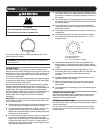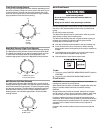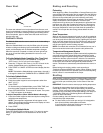
4
AquaLift
®
Self-Cleaning Technology
AquaLift
®
Self-Cleaning Technology is a first-of-its-kind cleaning
solution designed to minimize the time, temperature and odors that
ordinarily come with traditional self-cleaning methods. With
AquaLift
®
Self-Cleaning Technology, an exclusive coating on the
interior of the oven is activated with heat and water to release
baked-on soil. To use AquaLift
®
Self-Cleaning Technology, simply
wipe out loose debris, pour water into the oven bottom and run the
AquaLift
®
Self-Cleaning cycle. When the cycle finishes in under
1
hour at a lower temperature than in traditional self-cleaning
methods, just wipe out the remaining water and loose debris. See
the “Clean Cycle” section for more detailed instructions. For
additional information, frequently asked questions and videos on
using AquaLift
®
Self-Cleaning Technology, visit our website at
http://whirlpoolcorp.com/aqualift.
Surface Temperatures
When the range is in use, all range surfaces may become hot,
such as the knobs and oven door.
Baking Drawer
When the oven is in use, the drawer may become hot. Do not store
plastics, cloth, or other items that could melt or burn in the drawer.
Oven Vent
The oven vent releases hot air and moisture from the oven, and
should not be blocked or covered. Do not set plastics, paper or
other items that could melt or burn near the oven vent.
Preheating
When beginning a Bake, Convect Bake or Convect Roast cycle, the
oven will begin preheating after Start is pressed.
The oven will take
approximately 12 to 15 minutes to reach
350°F (177°C)
with all of
the oven racks provided with your oven inside the oven cavity.
Higher temperatures will take longer to preheat. The preheat cycle
rapidly increases the oven temperature. The actual oven
temperature will go above your set temperature to offset the heat
lost when your oven door is opened to insert food. This ensures
that when you place your food in the oven, the oven will begin at
the proper temperature. Insert your food when the preheat tone
sounds. Do not open the door during preheat before the tone
sounds.
Ceramic Glass Cooktop Cleaning
To avoid damaging the cooktop, do not use steel wool, abrasive
powder cleansers, chlorine bleach, rust remover or ammonia.
1. Remove food/residue with the Cooktop Scraper.
■ For best results, use the Cooktop Scraper while the
cooktop is still warm, but not hot to the touch. It is
recommended to wear an oven mitt while scraping the
warm cooktop.
■ Hold the Cooktop Scraper at approximately a 45° angle
against the glass surface and scrape the residue. It will be
necessary to apply pressure in order to remove the
residue.
Allow the cooktop to cool down completely before proceeding
to Step
2.
2. Apply a few dime-sized drops of affresh
®
Cooktop Cleaner to
the affected areas.
■ Rub affresh
®
Cooktop Cleaner onto the cooktop surface
with the blue Cooktop Cleaning Pad. Some pressure is
needed to remove stubborn stains.
■ Allow the cleaner to dry to a white haze before proceeding
to Step 3.
3. Polish with a clean, dry cloth or a clean, dry paper towel.
■ Repeat steps 1 through 3 as necessary for stubborn or
burned-on stains.
The Complete Cooktop Cleaner Kit is available for order including
the following:
■ Cooktop Scraper
■ affresh
®
Cooktop Cleaner
■ Blue Cooktop Cleaning Pads
See the “Accessories” section for part numbers and information on
ordering.
Key Usage Tips


















